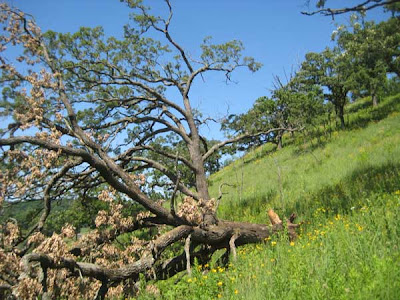Two kinds of Joe Pye weed
 Most people know Joe Pye weed (Eupatorium maculatum) as a wetland plant, but it turns out that it is also found in upland sites. I'm not sure why, and we certainly did not plant it, but we have scattered plants even in some of our drier and shadier oak woodland sites. The usual common name for this species is spotted Joe Pye weed. It is interesting that Cochrane and Iltis do not mention upland sites at all, indicating that it is characteristic of wet prairies, sedge meadows, marshes, and wet thickets.
Most people know Joe Pye weed (Eupatorium maculatum) as a wetland plant, but it turns out that it is also found in upland sites. I'm not sure why, and we certainly did not plant it, but we have scattered plants even in some of our drier and shadier oak woodland sites. The usual common name for this species is spotted Joe Pye weed. It is interesting that Cochrane and Iltis do not mention upland sites at all, indicating that it is characteristic of wet prairies, sedge meadows, marshes, and wet thickets.Where does the name Joe Pye come from? As usual, the origin is lost in antiquity, and one is reluctant to accept any non-authoritative source. According to one book, Joe Pye was an Indian healer from New England who used plants of this genus as medicinals.
 In the same upland sites where we have E. maculatum, as well as in all of our savanna sites, we have another Joe Pye weed species, Eupatorium purpureum, whose common name is green-stemmed or purple Joe Pye weed. (Kathie usually calls it woodland Joe Pye.) Cochrane and Iltis indicate that this species is common in southern dry or dry-mesic forests dominated by oaks, as well as in mesic maple and basswood forests. I have seen this species in forested habitats all over southern Wisconsin. However, according to UW Herbarium records, this species is confined almost exclusively to southern or western Wisconsin, whereas spotted Joe Pye is found almost all over the state. (The only county it is missing from is Lafayette County.)
In the same upland sites where we have E. maculatum, as well as in all of our savanna sites, we have another Joe Pye weed species, Eupatorium purpureum, whose common name is green-stemmed or purple Joe Pye weed. (Kathie usually calls it woodland Joe Pye.) Cochrane and Iltis indicate that this species is common in southern dry or dry-mesic forests dominated by oaks, as well as in mesic maple and basswood forests. I have seen this species in forested habitats all over southern Wisconsin. However, according to UW Herbarium records, this species is confined almost exclusively to southern or western Wisconsin, whereas spotted Joe Pye is found almost all over the state. (The only county it is missing from is Lafayette County.)Obviously, it is important to be able to tell these two species apart. Although some people use the color of the infloresence, the variability in color is so great that I would be reluctant to use that character. After extensive perusal of the literature, I have finally found a diagnostic character that seems to hold: the color of the stem node.
 As its common name indicates, the stem of spotted Joe Pye is indeed spotted, and it has pigment up and down the stem (see the photo here).
As its common name indicates, the stem of spotted Joe Pye is indeed spotted, and it has pigment up and down the stem (see the photo here). The stem of purple Joe Pye, on the other hand, is green (hence one of its common names), except at the nodes, at which there is a dark purple pigment (see photo at left). This pigment is very characteristic of this species. Thus, all you have to do is look at the stem nodes to tell these two species apart. I've looked at many Joe Pye weed plants and this characteristic seems to be quite consistent and very diagnostic.
The stem of purple Joe Pye, on the other hand, is green (hence one of its common names), except at the nodes, at which there is a dark purple pigment (see photo at left). This pigment is very characteristic of this species. Thus, all you have to do is look at the stem nodes to tell these two species apart. I've looked at many Joe Pye weed plants and this characteristic seems to be quite consistent and very diagnostic.Both of these species are in full flower right now, and E. purpureum is one of the commonest flowering plants in our shadier savannas.











